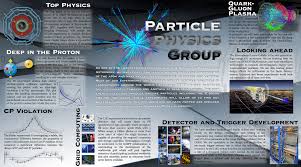An introduction to Particle Physics

Particle physics is the
study of the basic elements of matter and the forcesacting among them.
It aims to determine the fundamental laws that control themake-up of
matter and the physical universe. RALis one of the leading laboratories investigating this.
Probing Particles
Experiments at particle accelerators, such as LEP, where sub-atomic
particles collide at very high energies, reveal details of particlesand
conditions that prevailed just after the Big Bang over 15 billion years
ago.Most experiments involve large international collaborations and are performed atoverseas laboratories such as CERN in Geneva andDESY
in Hamburg. These collaborations typically involve more than 300 people
and the work at CERN is supported by 19 European countries.
Accelerators
The
accelerator is the basic tool of particle physics. It allows us to
createthe particle collisions that we want to study in our own
laboratories. The highenergy collisions between particles that
physicists are interested in do occurnaturally but the events are
unpredictable and the number that can be observed(in cosmic rays) is low.Accelerators
work by accelerating charged particles using electric fields. Alinear
accelerator accelerates particles in a straight line: the biggest
linearmachine, in Stanford, California, is two miles long. Circular
machines are morecommon. As well as accelerating the particles using an
electric field, circularaccelerators bend their p aths using a
magnetic field. In a machine like LEP atCERN, where they have opposite
charges, the particles being accelerated travelin opposite directions
until they are forced to collide. The drawback is thatthe faster a
particle travels, the harder it is to keep it moving in a circlebut, in
the largest circles (LEP is the largest in the world with acircumference
of 27km) less energy is wasted when accelerating particles to
highspeeds.
Detectors
Detectors are used to examine
tracks made by the new particles that are producedwhen accelerated
particles collide. In the early days photographic film, sparkchambers
and bubble chambers were used. Since the late 1960s electronicdetectors
have taken over. There are two basic kinds - tracking detectors
whichreveal the trajectories of individual charged particles, and
calorimeters whichmeasure energies. A modern electronic detector is
built like an onion, withlayers of trackers and calorimeters to give as
much information as possibleabout the particles produced in each
collision.
Antimatter is very much like ordinary matter, but it carries the oppositecharge. An anti-electron (a positively charged electron) is just another way ofdescribing a positron.Crashing
matter and antimatter together is now a dailyoccurence in machines like
LEP. The fact that the universe seems to be full ofmatter and not
antimatter is one of the most baffling problems in modernphysics. At
the time of the Big Bang, matter and antimatter are believed tohave been
produced in equal quantities. What seems to have happened is that, ata
somewhat later time, collisions between the two types have destroyed
all theantimatter but left a little of the matter behind, from which our
universe ismade. The reason may be due to a tiny asymmetry in the way
particles of matter andantimatter decay, thereby creating an excess of
matter.
Big Bang Science
It is thought that the universe
began around 15 billion years ago in the Big Bangand that it has been
cooling down and expanding ever since. For physicists, themost
interesting time was within the very first moment (within 10^-34
seconds)where the conditions were so extreme that the laws of physics as
we know themtoday didn't apply. After about 0.01 seconds, the universe
was cold enough forquarks to stick together, forming protons and neutrons.
These formed the firsthelium nuclei after 100 seconds, but the first
atoms didn't appear for 100,000years. After a few billion years stars
began to form, using hydrogen and heliumto build the heavier elements
that make up the familiar world around us -elements heavier than helium
owe their origin to stars.The Big Bang theory correctly predicts that
about 75% of all visible matter ishydrogen and about 25% helium. (All
other matter accounts f or less than 1%.)Another great success of the
theory is the presence of background microwaveradiation in our universe,
a relic of the Big Bang.
We
know from observing the rotation of galaxies that about 90% of the
matterthey contain is invisible to us. The matter we can't see is
called "missing" or"dark" matter. The amount of dark matter contained
in the universe is crucialto its fate. If it is greater than a certain
amount, the universe willeventually collapse. Below this, and it will
keep on expanding for ever.There are many ideas about what dark matter might be, ranging from exotic newparicles to black holes. One idea says that the neutrino,an
abundant fundamental particle which is thought to have zero mass,
actuallyhas a tiny mass. However, neutrinos generally move about the
universe quicklyand are not stuck together in clumps, as they would need
to be to explain the rotation of the galaxies. The most recent
explanations of dark matter therefore use a combination of "hot" matter,
like neutrinos, and "cold" matterlike black holes. The true answer has
yet to be found. Underground experimentson dark matter are taking place now.

कोई टिप्पणी नहीं:
एक टिप्पणी भेजें